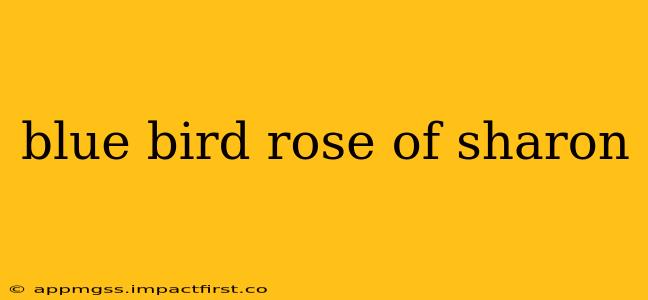The Blue Bird Rose of Sharon, scientifically known as Hibiscus syriacus 'Blue Bird', is a captivating shrub prized for its vibrant, azure-blue flowers. This variety stands out among the many Rose of Sharon cultivars, offering a unique color that adds a touch of elegance and serenity to any garden. This comprehensive guide will delve into its characteristics, care instructions, and answer some frequently asked questions surrounding this beautiful plant.
What is a Blue Bird Rose of Sharon?
The Blue Bird Rose of Sharon is a deciduous shrub belonging to the mallow family (Malvaceae). It's known for its large, showy flowers that bloom profusely throughout summer and into early autumn. Unlike many other Hibiscus varieties, the 'Blue Bird' cultivar boasts a striking lavender-blue hue, often described as a periwinkle or light blue-purple. The flowers possess a characteristic hibiscus shape with five petals, a prominent staminal column, and a delicate texture. The plant itself can grow to a height of 8-10 feet and a similar spread, making it a substantial addition to the landscape.
What are the care requirements for a Blue Bird Rose of Sharon?
Sunlight and Soil:
This shrub thrives in full sun to partial shade. At least six hours of sunlight per day are ideal for promoting abundant blooms. Well-drained soil is essential; heavy clay soils should be amended with organic matter to improve drainage and aeration. It tolerates a wide range of soil pH levels.
Watering:
While established plants are relatively drought-tolerant, regular watering, especially during dry periods, will encourage vigorous growth and abundant flowering. Deep, infrequent watering is preferable to shallow, frequent watering.
Pruning:
Pruning is generally not necessary, but you can lightly prune the Blue Bird Rose of Sharon in late winter or early spring to remove dead or damaged branches and maintain its shape. Heavy pruning should be avoided as it may reduce flowering.
Fertilizing:
A balanced, slow-release fertilizer applied in early spring can enhance flowering. However, over-fertilizing should be avoided, as it can lead to excessive vegetative growth at the expense of flowers.
How tall does a Blue Bird Rose of Sharon grow?
A mature Blue Bird Rose of Sharon typically reaches a height and spread of 8-10 feet. However, this can vary depending on growing conditions, such as sunlight, soil quality, and available moisture. Regular pruning can help manage its size and shape.
When does a Blue Bird Rose of Sharon bloom?
The Blue Bird Rose of Sharon typically blooms from mid-summer to early fall, extending its blooming period significantly compared to some other flowering shrubs. This long blooming season makes it a valuable addition to any garden, providing color throughout the warmest months.
Is the Blue Bird Rose of Sharon invasive?
No, the Blue Bird Rose of Sharon is not considered an invasive species. Unlike some other Hibiscus species, it remains relatively contained within its planting area and doesn't aggressively spread through underground runners or self-seeding.
How to propagate Blue Bird Rose of Sharon?
Propagation can be achieved through cuttings or layering. Softwood cuttings taken in the early summer have a high success rate when placed in a rooting hormone and kept moist under humid conditions. Layering involves bending a low-growing branch to the ground, burying a portion of it, and waiting for roots to develop before separating it from the parent plant.
Conclusion
The Blue Bird Rose of Sharon is a beautiful and relatively low-maintenance shrub that adds a unique touch of blue to any landscape. With its stunning flowers and extended blooming season, it's a worthwhile addition for gardeners of all levels. By following the care guidelines outlined above, you can enjoy the beauty of this exceptional plant for years to come. Remember to always research your specific local climate and soil conditions for optimal results.
